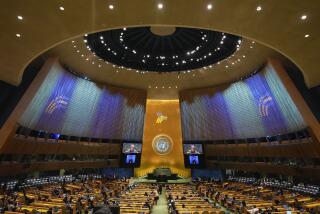And Now, Moving On To START : Summit Sets Stage For New Treaty, But Caution Is Watchword
- Share via
The wheels were not even up on Mikhail S. Gorbachev’s plane Thursday evening before Americans were being flooded with the views of journalists and commentators on the results of the three-day summit between President Reagan and the Soviet leader.
Who won? As President Reagan said Friday, both leaders won, as did “the people of both countries.” By signing the treaty on intermediate-range nuclear forces, President Reagan has diffused the arms-control issue and transformed his image into that of the great peacemaker.
Gorbachev mesmerized the media and the American public, while giving away very little on critical issues such as Afghanistan and human rights. The bulk of time and effort was was spent on arms control, as the Soviet leader preferred.
Nor, contrary to what some “spin merchants” are suggesting, did Gorbachev give in on “Star Wars.” The section of the joint statement issued at the summit’s conclusion that dealt with space weapons was carefully crafted to allow each leader to walk away saying that he had protected his own position. In his post-summit press conference, Gorbachev reiterated his opposition to the Strategic Defense Initiative and pointed out that the two sides had again committed themselves to remain within the anti-ballistic missile treaty (which limits anti-missile weapons testing and deployment) “as signed in 1972.”
President Reagan could also correctly assert that the joint statement did not commit him to keep SDI testing within the “narrow” or traditional interpretation of the ABM treaty (a fight he has been waging with both the Soviets and the Congress since 1985). Left unsaid is that the President is already required to keep SDI within the traditional interpretation, through fiscal year 1988, under the terms of the defense bill that he signed last month. The Soviets understand this quite well, which is why they are willing to proceed swiftly toward completing a strategic arms reduction treaty, or START, without explicit constraints on SDI testing. They also understand that in the long run, budgetary constraints, a new President and the implementation of the reductions mandated by a START treaty could all lead to reduced support for SDI.
Why wasn’t there a “breakthrough” on START at the summit? In fact, significant progress on strategic arms reductions was achieved. Previously, the two sides had agreed to an overall cut of about 50% in strategic nuclear forces, to an overall ceiling of 6,000 missile warheads and 1,600 missile launchers and heavy bombers.
Among the issues that remain outstanding: What additional subceilings should be agreed to? Should mobile missiles be banned? Should nuclear cruise missiles be limited? What additional verification measures, above and beyond those agreed to in the INF treaty, will be required?
Progress was made in most of these areas. A subceiling was agreed to of 4,900 total warheads for land- and sea-based ballistic missiles. The Soviet Union further agreed explicitly to a 50% reduction in the payload or throwweight of ballistic missiles, in addition to a 50% cut in its heavy missiles (both had long been U.S. demands).
The United States conceded that nuclear cruise missile deployments could not run free and agreed, for the first time, to limit the deployment of sea-launched cruise missiles (and the two sides discussed new technical approaches to their verification).
Finally, the two sides had extensive discussions on what verification measures could be carried over from the INF treaty’s inspection and elimination protocols and on what additional measures would be needed. They reached some agreement on rules for counting warheads on missiles and air-launched cruise missiles on heavy bombers.
In their joint statement, the two leaders spoke of having instructed their negotiators to “accelerate resolution of issues within the (START) joint draft treaty text,” with the objective of signing an agreement at a Moscow summit. Thus, an important deadline has been set that will force bureaucracies within each government to make concessions and trade-offs.
What should be the goals of a START treaty? As we reach the end game on START, we must be sure to achieve strategic arms cuts that actually lessen the risk of nuclear war by enhancing the survivability and reducing the vulnerability of our deterrent forces. That is, the reductions should not increase the ratio of Soviet warheads targeted on our land-based missiles and bombers, or reduce significantly the number of missile submarines (the core of our nuclear deterrent) that we can keep at sea.
There are several steps our negotiators could take to protect these objectives. First, we should try to enhance the survivability of our land-based missiles as reductions are implemented. There are indications that Washington is prepared to move slightly away from its previous position--that mobile missiles should be banned outright--toward the view that limited deployments of survivable, single-warhead missiles could be permitted if done in a way that assured effective verification. This is the right way to go.
We also must take actions to preserve the survivability of our sea-based nuclear deterrent. The Soviets must show flexibility on warhead and launcher limits in a way that allows us to maintain a sufficient number of missile submarines at sea. One possible trade-off pertains to the Trident II, which would be the first U.S. submarine-based missile capable of destroying Soviet missile silos. Because of its accuracy and short flight time, the Trident II is the new development the Soviets fear the most. This gives Washington some useful bargaining leverage. The Soviets might be willing to allow the United States to deploy as many submarine-launched missiles as it desired, within the overall 4,900-missile warhead ceiling, in exchange for significant limits on the number of Trident IIs that America could deploy.
As each side knows, in the long run a START agreement is a vital complement to the just completed INF treaty. Without limits on strategic forces, elimination of INF missiles can be easily overcome by simply re-targeting a few hundred of the thousands of strategic warheads each side possesses.
Completing a START treaty in time for the Moscow summit is certainly possible. But U.S. and Soviet negotiators must work with care. Reductions are important, but they must not exacerbate the potential vulnerability of vital elements of our strategic deterrent.
More to Read
Sign up for Essential California
The most important California stories and recommendations in your inbox every morning.
You may occasionally receive promotional content from the Los Angeles Times.












